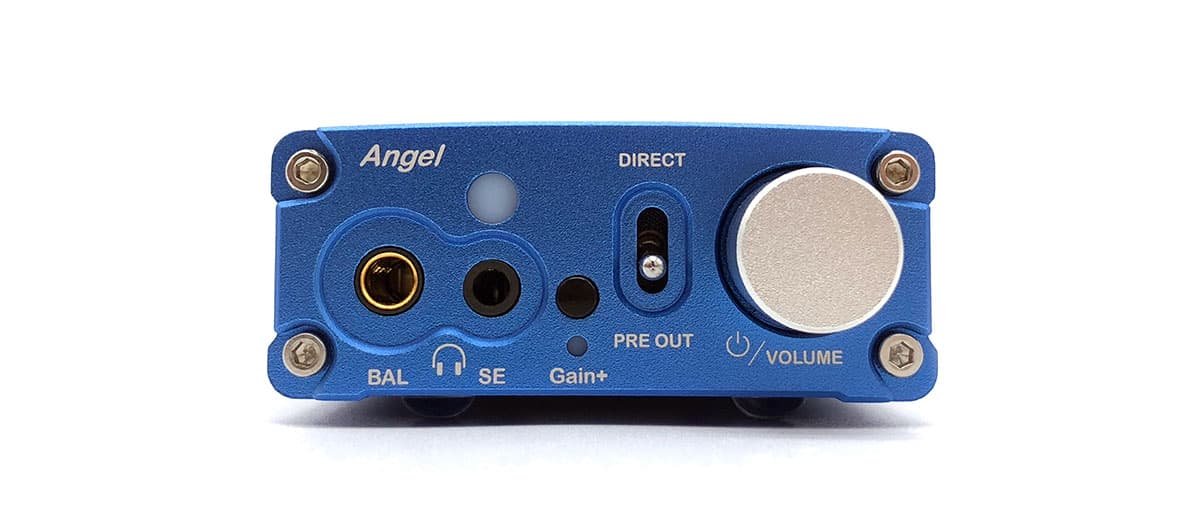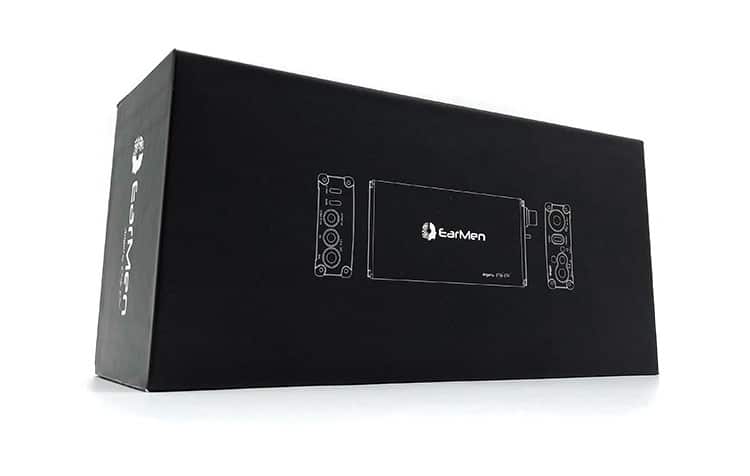Synergy
Power
When on the go, the amplifier of the Angel is capable enough to keep in low gain to squeeze out that extra listening time on battery power. With the power the Angel is putting out, it already offers a lot of headroom even without the Gain+ engaged.
Here I found no hiss listening through the Raptgo Hook-X and only had to turn the volume wheel 8-10 notches from zero to reach a normal listening level.
Keeping the Angel on low gain, both the Audio-Technica ATH-ADX5000 and the Dan Clark Audio Ether 2 I had it paired with never reached above the yellow volume range of 25-50%.
I still wouldn’t dismiss the availability of the Gain+ button especially when the unit is plugged into the wall. The Angel wouldn’t sweat keeping the drivers of any less efficient dynamic drivers and power-hungry planar cans moving.
Pairings
I’m always excited whenever a new potential pairing for the ATH-ADX5000 comes along. A very revealing set with a rousing timbre mixed with a punchy low-end, feed the 420W drivers with lackluster energy and the whole act will fall apart.
With the Angel, the ATH-ADX5000 not only sounded correct but the brighter leanings of its upper midrange to lower treble was never pushed beyond what I expected. And washing away my new-gear bias with the C3R, it is through the Angel that the vocal tendencies of the ATH-ADX5000 sounded more at ease instead of being hurried.
Swapping to the Ether 2 any excess energy that may cause fatigue is quelled since it has a more held-back treble region. I like how it complemented my initial experience with the Angel putting into perspective how little this device tampers with the timbre of paired cans.
I am equally impressed with the level of detail and dynamics it pushed out of the Ether 2 drivers. And for a lengthier listening session, the Ether 2 will serve as the better partner in adding that heft and weight to the otherwise lightweight picture of the Angel.
I continued to experiment with the Angel and listened to its DAC section through the Burson Funk w/ V6 Classic op-amps installed. The characteristic warmth of the Funk added a welcome coloration for less serious listening impressions.
With the Sennheiser HD560s plugged into the Funk, the pairing weakened the speed of the bass but the exacting and spacious nature of the headphone is maintained.
Tapping the speaker section, the Funk and Monitor Audio Silver 50 tandem resulted in a very vivid and etched midrange which surprised me since I am usually using these two with the Chord Qutest.
Select Comparisons
CEntrance HiFi-M8 V2
$749.99
Technical
Featuring some features that make it stand out, the HiFi-M8 V2 should be on the radar of those with $800 to splurge on a shiny new DAC/Amp.
It even stacks well with the Ampersand, a beefy 3W amplifier from the same company. Not that the HiFi-M8 V2 is insufficient, on the contrary, it is pushing a generous 1.6W on its own coming from the class-A balanced circuit inside.
Whilst missing dedicated lineouts and tapping out to a max of 384kHz PCM sampling rate, the HiFi-M8 V2 shouldn’t be scoffed at when talking feature sets.
From a calibrated VU meter, EQ controls, stamina mode, and the option to stream through Bluetooth, CEntrance is the one that has built the more flexible platform.
Design
The tank-like profile of the HiFi-M8 V2 may tell otherwise but it is the Angel that is the denser device. Both made of metal, the function over form theme presented by the HiFi-M8 V2 stresses its intended audience of professionals whereas the case of the Angel will surely attract more casual enthusiasts.
With more functions to get into, CEntrance needed to be more creative in fitting everything and has settled into using mini toggle switches and thumb wheels.
Comparing the face of the two devices, one striking similarity is the presence of screws in each corner. The assembly of the HiFi-M8 V2, however, seems to be divided into four pieces instead of only three.
Lastly, it’s not like the HiFi-M8 V2 is devoid of class. Having a prominent VU meter with white LEDs dancing on top, a feature not present in the Angel, CEntrance subtly balances out its downside of having a busier interface.
Performance
There are moments when the HiFi-M8 V2 philosophy of being geared towards professionals shows a less inviting attitude compared to the Angel. But whenever it begins showing a bit of personality, it brings me back to the probable reason why CEntrance found success with its portable device.
Punching harder but tuned a bit drier, the HiFi-M8 V2 offers a closer to neutral emphasis on low-end. With less presence in building up an immense thump, it gives the advantage over to the Angel for showing a more detailed sub-bass extension and enormity.
Bite on the CEntrance camp may be less but since it has the more behaved tendency, it gives much clearer support when building a busy scene. This, however, means that sometimes the HiFi-M8 V2 will have a harder time being seen.
The HiFi-M8 V2 begins to show its muscle when compared to the lighter vocal timbre of the Angel. Talking about some obvious differences between the two, the HiFi-M8 V2 adds power to singers while the Angel focuses on transparency.
When listening to the same guitar tracks that I used with the Angel in the HiFi-M8 V2, strings tend to have a softer twang on the latter. This helps the HiFi-M8 V2 in taking away that extra shimmer when paired with a bright device.
Completing the picture, the treble on the HiFi-M8 V2 is less clinical sounding. Infused with a slight melodic timbre, it is a departure from the thinner yet crisper sound the Angel gives to electric guitars.
Both can precisely pinpoint the location of an off-centered singer and place the serenade of a violin in an isolated space. The Angel though is the much wider staging device sending far objects with a less constrained composition.
Chord Electronics Mojo 2
$725.00
Technical
With the Mojo 2, as tiny as it is compared to the Angel, Chord managed to bake into their popular portable DAC/Amp an impressive amount of tech.
Inside the Mojo 2 is Chord’s signature FPGA circuit technology that processes digital audio and aids in extending battery life. With only a slight setback in music playback compatibility, the Mojo 2 is teasingly appealing as it provides the ability to tinker with the sound using its ‘transparent’ EQ settings.
However, when we begin looking at the analog side of things, the Mojo 2 begins to show its more portable demeanor. With only two 3.5mm jacks as output, the Mojo 2 when paired with a 30W load is rated to a maximum of 600mW output power.
Design
Little introduction is needed for the Mojo 2 having mainly retained its predecessor’s case with the addition of a fourth button for the menu and a new USB-C input. And to compare it shortly, this dinky device from Chord is less brick-like and more fluid to hold than the Angel.
Of course, the size of the Angel will be less of a concern when it is placed on a desk. It is where the Angel will feel the most at home whereas the Mojo 2 at a lighter 185g will be easier to handle for on-the-go listening.
The controls of the Angel are more conventional and straightforward when compared to the four orbs used to access the settings of the Mojo 2. And while both use digital volume, I do find that the increment on the Mojo 2 is more granular.
The smaller device also has its detriments since, in its quest to be backward compatible with the Poly, Chord had to design the USB-C input in an awkward position below the unit. This and having to use a micro-USB when charging are a few things to consider.
Performance
Even without touching any of the default settings, the Mojo 2 will still be noticed as the more enjoyable device. Chord affixed its signature circuitry for the very obvious purpose of housing its unique sound.
The bass of the Mojo 2 will not offer the same level of tightness perceived in the Angel for some added weight and sweetness. It still doesn’t stray far from what a clean and detailed kick drum should sound like so the more forward presence wouldn’t appear overly emphasized.
Guitars will enjoy a steelier plucking ring with the Angel since the Mojo 2 will tweak the sound to be on the softer side. This trait affects the technicalities of the latter making it less etched when compared.
Filling the midrange with weight and warmth that doesn’t overstep the natural timbre of the singers, the Mojo 2 astounds with its careful balance. But even with its more intimate placement and impressive dynamic properties, breathiness is still a hair more defined on the Angel.
Surprisingly close in the tuning of shimmery chimes and crashing cymbals, the Mojo 2 offers a slightly more striking attack. For abrupt and forceful horn passage, the image will come up as energetic and bigger than the Angel with a satisfying definition and notable driver control.
Our Verdict
The EarMen Angel conceals in its cool form factor an excitingly transparent sound comparable to full-size desktop counterparts that inspires listening on the go with confidence.
And instead of increasing the list of feature sets, in exchange, EarMen focused their efforts on optimizing the circuitry of their latest portable DAC/Amp to compete with sound. As it boxed with close peers, there was never a moment that it showed weakness and let the others pull ahead.
I thoroughly enjoyed its non-imposing tonality that simply flavors the sound in ways that do not upset accuracy. And pairing has been a blast since it was able to show finesse with every gear that I can throw at it.
EarMen Angel Technical Specifications
- DAC: ES9038Q2M
- Input: USB-C x 2 (Data & Charging), S/PDIF (Coax/Tos)
- Headphone output: 3.5mm, 4.4mm
- Lineout: 3.5mm, 4.4mm
- Audio Format: Native DSD512, up to 768kHz DXD, up to 768kHz PCM, MQA
- Battery: 2xLi-Po 3000mAh
- Charge: Use 5V >= 2A adapter
- Dimensions: 152 x 27 x 66mm
- Weight: 340g/0.75lbs.






